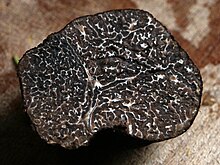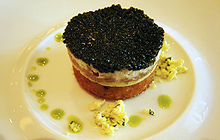



A delicacy is a rare food item that is considered highly desirable, sophisticated, or peculiarly distinctive within a given culture or region. A delicacy may have an unusual flavor or be expensive compared to everyday foods.
Delicacies vary across countries, customs, and ages. Some delicacies are confined to a certain culture, such as fugu in Japan and ant larvae (escamoles) in Mexico, or may refer to specific local products, such as porcino, venison or anchovy.
Culture plays a role in determining what is considered a delicacy. The long-standing tradition and practice of insect consumption represented in Oaxaca, Mexico has occurred for centuries.[1] The availability of foods or particular ingredients may determine the types of delicacies associated with different cultures.
See also
- Acquired taste
- Chinmi – Includes a list of Japanese delicacies
- Delicatessen
- Specialty foods
References
- ^ Cohen, Jeffrey H; Sáánchez, Nydia Delhi Mata; Montiel-Ishino, Francisco (1 February 2009). "Chapulines and Food Choices in Rural Oaxaca". Gastronomica. 9 (1): 61–65. doi:10.1525/gfc.2009.9.1.61. ISSN 1529-3262.








